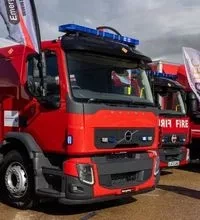How hydrogen power can be part of the future transport mix

Underdeveloped infrastructure and the heavy use of fossil fuels hardly sounds like a recipe for success, so why the renewed optimism that hydrogen-powered transport will soon fulfil its potential?
In 2021, the International Energy Agency reported that there were 51,600 fuel cell electric vehicles worldwide, and 730 hydrogen refuelling stations, the vast majority in China, Korea, Japan and the US.
Here in the UK, the number of filling stations then dropped to single figures, with the closure of three Motive sites at Cobham, Gatwick and Swindon.
A thorny issue has always been that 90% of global hydrogen is derived from coal, gas and oil. Hopes are very much pinned, therefore, on ‘green hydrogen’, made using electricity from renewable sources.
Turning tide
Bill Elrick, Executive Director of the US-based Hydrogen Fuel Cell Partnership, admitted: “Up until two years ago, I knew we were in an uphill battle and I didn't see a wave that would change anything. I think something has shifted.”
A turning point came, in July last year, when Bosch put hydrogen front and centre of its prestigious Tech Day. “Here in Stuttgart-Feuerbach, the hydrogen future is about to happen,” said Dr Stefan Hartung, Chairman of the Board of Management. Bosch plans to invest €2.5bn in hydrogen technologies by 2026.
What’s more, the EU’s new Alternative Fuels Infrastructure Regulation requires hydrogen refuelling stations to be constructed in every major urban area and every 200km along the core road network by 2030.
On this side of the Channel, in December 2023, the government announced a significant update to its 2021 Hydrogen Strategy, including £400m over three years for 11 new green hydrogen projects.
Secretary of State for Energy Security and Net Zero, Claire Coutinho, said: “Hydrogen presents a massive economic opportunity for the UK, unlocking over 12,000 jobs and up to £11bn of investment by 2030. Today’s announcement represents the largest number of commercial scale green hydrogen production projects announced at once anywhere in Europe.”
Key UK sites include:
- South East logistics hub, the Port of Tilbury, which is working with energy company RWE and investment company Mitsui on a 10-megawatt green hydrogen plant, increasing to 100+MW capacity within 10 years.
- Teesside International Airport in the North East, where the £4.1m Element 2 project will develop a large hydrogen refuelling station to support long-term trials of passenger cars, vans and airside vehicles.
- The Hydrogen Aggregated UK Logistics (HyHAUL) project on the M4 Corridor, where green hydrogen specialist Protium has secured £30m to deploy 30 fuel cell trucks by 2026, increasing to 300 vehicles by 2030.
Wales & West Utilities (WWU) has already added a First Hydrogen FCEV van to its 1,300-strong vehicle fleet, operating from the energy provider’s depot in Swansea.
WWU fleet manager, Stephen Offley, said: “We expect to deploy hydrogen-fuelled vans at the earliest practicable opportunity, initially in smaller clusters within a convenient radius of the hydrogen refuelling location."
Heavy duty applications
At last year’s Commercial Vehicle Show, Glasgow-based Hydrogen Vehicle Systems (HVS) unveiled its impressive 40-tonne technology demonstrator – the first hydrogen HGV to be designed and built in the UK.
Dr David Telford, Chief Commercial Officer at HVS, said: “We have focused on green hydrogen as a sustainable fuel solution. For many HGV long-haul applications, we believe that the efficiency of the FCEV powertrain with regenerative braking and using e-hydrogen directly offers the most compelling solution.
“It is important to remember that it’s not a battle, hydrogen vs battery, but about what technology is best suited to decarbonise the required application. As hydrogen refuelling infrastructure becomes more widely available, hydrogen vehicles of all sizes will become more attractive due to the quick refuelling times.
“The current lack of infrastructure is the biggest challenge. However, a wider hydrogen ecosystem is not an essential part of the transition as most long-hauls are point-to-point between distribution centres, or in back-to-base operations. We estimate we can cover 90% of UK HGV use on the motorway network with 7-10 hydrogen refilling stations.”
There will always be a debate about what technology is going to take the mantel from combustion engines. The truth is that it could well be a mix of propulsion technologies. Each has obstacles to overcome, but money is being invested to help take them mainstream, so it’s a case of when not if.
Interested in training on hydrogen? The IMI offers the Level 1 Award in Hydrogen Vehicle Awareness, covering basic safe working and refuelling.




